Improving your sales numbers requires a healthy helping of cold hard data—the kind of data that only sales tracking software can provide.
With a quality sales tracking platform, you can easily tell which of your sales strategies are working and which should be kicked to the curb.
Keep reading to learn what sales tracking software is, what a proper sales tracker tool looks like, and the 12 best sales tracking software options available to you.
Sales tracking software refers to any software tool that enables sales teams to quickly and accurately track their sales activities.
Sales tracking software helps you better understand your target buyers, identify potential pipeline issues before they become massive problems, and improve individual sales rep performance via detailed analytics that quickly pinpoint what works and what doesn’t.
Sales tracking software helps you:
Now that we know why sales tracking software is important, we can discuss the 12 best software solutions in this category.
The options below aren’t listed in any particular order. Each has its own benefits and drawbacks that you’ll need to assess for yourself. But all 12 tools will help you better track your sales activities and improve as a seller.
Let’s take a look!
| CRM name | Key features |
| Nutshell | Sales report, forecast report, loss report, sales funnel, activity report, downloadable charts, sales process automation, contact management, in-app email capability with automated sales email sequences, integrations with other tools |
| Salesflare | Integrated web tracking, automated email sequences, email signature sync, visual drag-and-drop pipelines, customizable stages, custom fields, integrations with other tools |
| EngageBay | Sales funnel automation, deal pipeline creation and tracking, sales task assignment and tracking, lead scoring, revenue dashboard, in-built telephony and SMS broadcasts, automated email sequences, auto-dialing and call scripts, integrations with other tools |
| BIGContacts | Comprehensive sales pipeline view, customizable sales pipeline stages, in-depth sales reports, automation of redundant tasks, custom triggers for automated tasks, webform connection, contact records |
| Pipedrive | Lead management, communications tracking, pipeline automation, detailed reporting, goal-setting, sales forecasting, customizable dashboards and reports, email automation and tracking, mobile app availability, integrations with other tools |
| Zoho CRM | Customizable dashboards, contact management, funnel charts, sales forecasting, detailed analytics, automated workflows, sales trends, gamification |
| Bitrix24 | Lead generation, visual pipelines, automation of sales processes and email communications, analysis of sales metrics |
| Copper | Contact management, visual pipeline, sales forecasting, detailed analytics, automation, iOS and Android app |
| FreshSales | 360-degree view of leads, lead scoring, sales task management, iOS and Android app, free plan with additional paid options |
| Close CRM | Detailed reporting, individual and team performance tracking, pipeline overviews, won and lost opportunities tracking, generated revenue metrics, email and SMS messaging tools, in-app phone and video calling |
| Salesforce | Visual pipelines, sales forecasting, contact management, plenty of customization options, and scalability |
| Keap | Visual sales funnels, in-depth sales reports, sales forecasting, contact management features, and numerous automation capabilities |
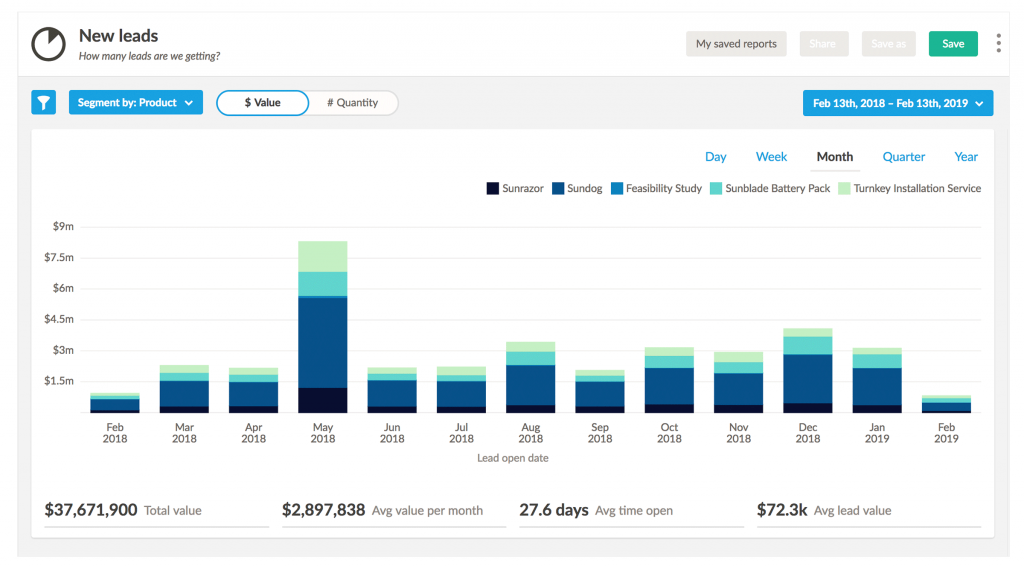
We may be biased, but Nutshell really is an amazing sales tracking software platform! It’s both easy to use and incredibly powerful, which means you’ll be able to quickly view your leads and their current place in your pipeline, assess important metrics like conversion rate and revenue per sale, and analyze your sales activities without needing a degree in rocket science.
Nutshell is loaded with high-end sales reporting features like:
These sales reporting features are in addition to the other sales tools Nutshell gives users access to, such as sales process automation, intuitive contact management, and in-app email capability complete with automated sales email sequences.
$ 192
per yearper user per month
per user per month
per user per month
per user per month
Nutshell
1 User/s $
$ 0
$ 0
$ 0
Annual Charge $
$ 0
$ 0
$ 0
Additional monthly charge $
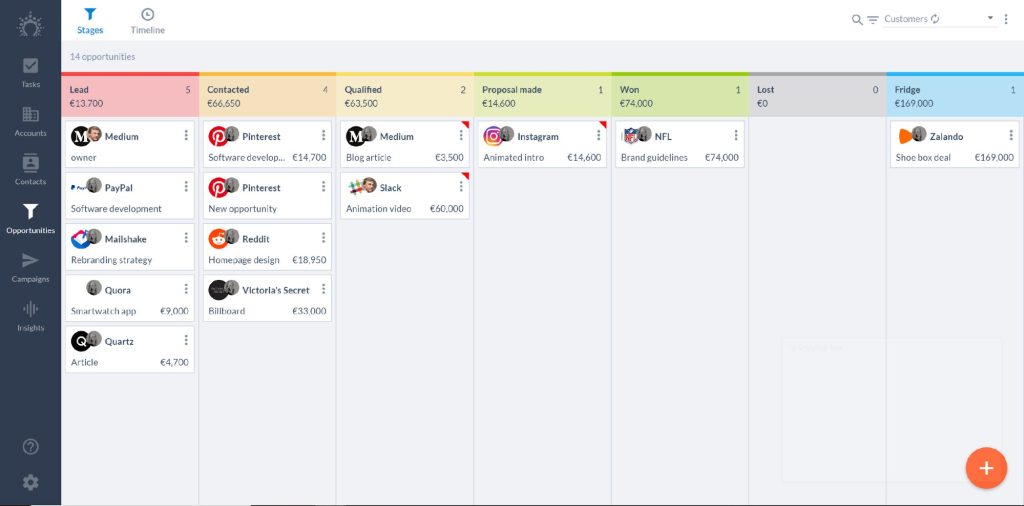
If you want to track your sales and don’t want to spend your time keeping track of it all manually, then you should definitely have a look at Salesflare.
Salesflare is a sales CRM that is built to keep track of your sales leads and customer data automatically by gathering all the data about them from your emails, calendar, phone, social media, company databases, email, and web tracking.
Based on that, Salesflare can nudge you automatically to follow up, plus provide you with all of the handy metrics, dashboards, and overviews covering everything we mentioned above.
There are three features that will especially come in handy:
1. Integrated web tracking: Salesflare doesn’t only track when people open your emails and click on them. It also shows you which pages these people visit on your site, when and for how long.
2. Automated email sequences: Want to reach out to people with a series of emails until they reply? Or just trigger an email when something happens? All of this is possible with Salesflare’s “Workflows” feature.
3. Email signature sync: Find yourself manually inputting phone numbers and addresses? Salesflare detects this information in email signatures and automatically adds it to the CRM database.
In addition, Salesflare offers visual drag-and-drop pipelines with customizable stages as well as custom fields, and it integrates neatly with Gmail, Office 365, and 3000+ other software tools.
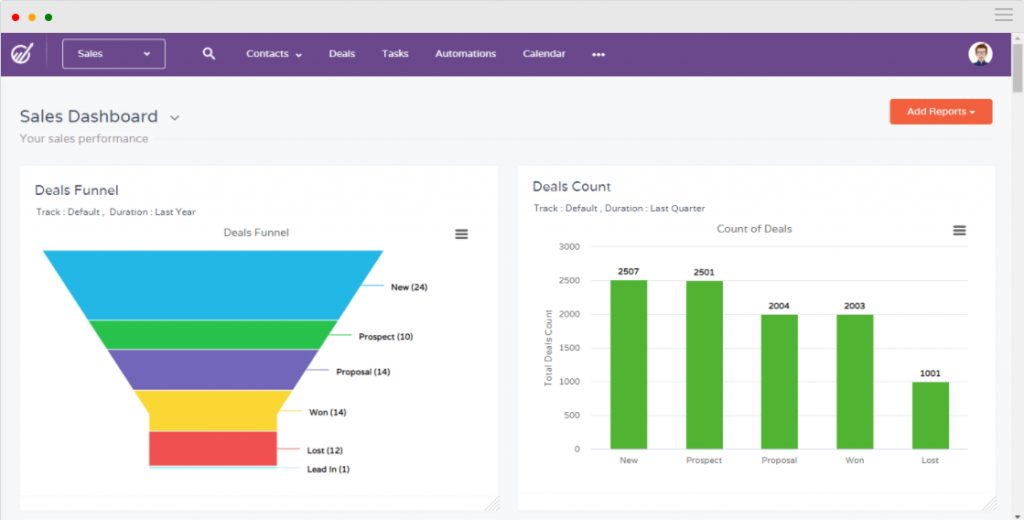
EngageBay comes packed with a lot of cool features designed with small business owners in mind. This tool offers a smart, intuitive UI which makes it easy to give your sales strategy a shot in the arm.
EngageBay can integrate easily with Gmail or Office365 for two-way sync, and also with other sales tools you may be trying. The software lets you automate your sales funnel easily, create and track multiple deal pipelines, assign and track specific sales tasks, score your leads based on customer action triggers, and manage all your revenue updates from one simple dashboard.
EngageBay also offers in-built telephony, SMS broadcasts, email autoresponders, automated email sequences for lead nurturing, auto-dialing, call scripts, business proposal analytics, and a raft of awesome features.
You can also integrate this tool with your other calendar apps and schedule all appointments from one place, with auto-reminders for the user and the customer.
What EngageBay stands out for is the feature-rich package that’s free for 15 users per account forever. Of course, if you need to scale beyond the 1,000-contact limit of the free version, you’ll need to pay up, but it’s a great platform to try out for no cost at first.
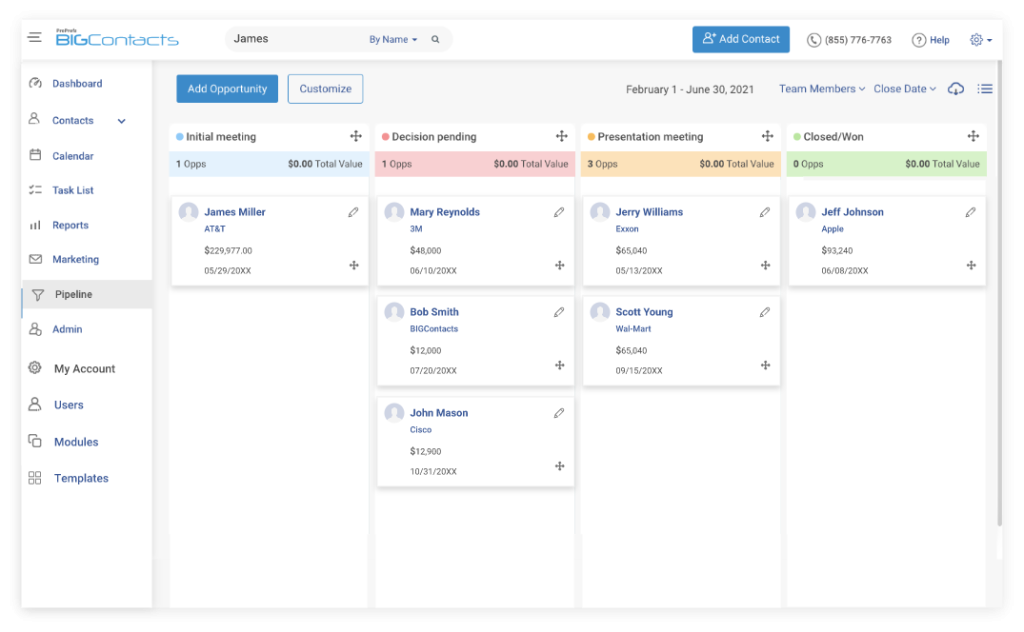
BIGContacts is a dynamic and powerful CRM tool that helps establish an automated sales workflow to enhance your bottom line. It can help you maximize profits by streamlining processes, setting-up reminders, and enabling you to focus on the right prospects.
BIGContacts offers a comprehensive view of the sales pipeline, making opportunity tracking easier. You can customize the sales pipeline stages according to your existing sales process and move opportunities along by simply dragging and dropping them. It offers in-depth sales reports, empowering you to track essential metrics such as close rate, sales cycle length, and customer lifetime value.
With BIGContacts, you can automate redundant tasks such as follow-ups or data entry and define custom triggers for them. The CRM tool also lets you capture more leads and their data with its webform connection. Sales executives can access a 360-degree view of contact records, including all personal details, previous touches, buying preferences, and upcoming events, to craft more personalized customer experiences.

Pipedrive is a tool that’s been “designed to keep you selling.” To help with this mission, Pipedrive gives users access to lead management, communications tracking, pipeline automation, and detailed reporting features.
It also has a few handy sales tracking solutions that you should be aware of. For example, Pipedrive gives users access to a “deal rotting” tool, which notifies sales reps when a potential deal stays idle for too long. That way they can change their sales approach and attempt to rescue deals before they become missed opportunities.
In addition, Pipedrive offers contact management, visual pipelines with customizable stages, automation for repetitive administration tasks, and an AI powered sales mentor that will offer personalized tips to help sellers improve their sales performance.

More than 150,000 businesses use Zoho CRM because of its rich feature set. The software comes with a wide variety of sales tracking tools including customizable dashboards, contact management, funnel charts, sales forecasts, and detailed analytics.
There are three features we especially like about Zoho CRM:
Zoho CRM is a solid tool for most sales teams, though companies that already use Zoho’s other software tools may find it the most enticing.

Bitrix24 is a powerful app that provides a wide range of collaboration, communication, project management, and sales tools to small businesses everywhere. Because its offerings are so extensive, some companies may prefer to use a simpler, more streamlined option.
That doesn’t mean Bitrix24 isn’t suitable for sales tracking purposes, though. In fact, the software has many features that can benefit sales professionals.
Bitrix24 offers users a quality CRM solution that they can use to generate leads, manage an infinite number of visual pipelines, automate sales processes and email communications, and analyze sales metrics like sales rep activity and total revenue.
The best part? Bitrix24 can be used for free, forever! The software company makes money when its customers use its built-in telephony, order more than 5GB of document storage, or design tasks with more than five dependencies. Because of this, Bitrix24 is a solid option for cash-strapped businesses looking for a quality sales tracking software.

Copper is a popular CRM tool that’s specifically designed for G Suite users. When the power of Copper and Google are combined, sales reps can easily manage their contacts, deals, emails, files, and more from a single location.
In regard to sales tracking, Copper allows its users to monitor new leads through each stage of the sales funnel, while analyzing important metrics like sales revenue per month.
One area where Copper really shines is in its use of automation. Entire sales processes can be automated, which increases productivity for users. For example, when a new lead emails a sales rep, contact information and sales rep activity can be automatically cataloged.
Copper also includes contact management, a visual pipeline, sales forecasting tools, a detailed analytics dashboard, goal setting, and an iOS and Android app so that sales reps always have access to their sales data.
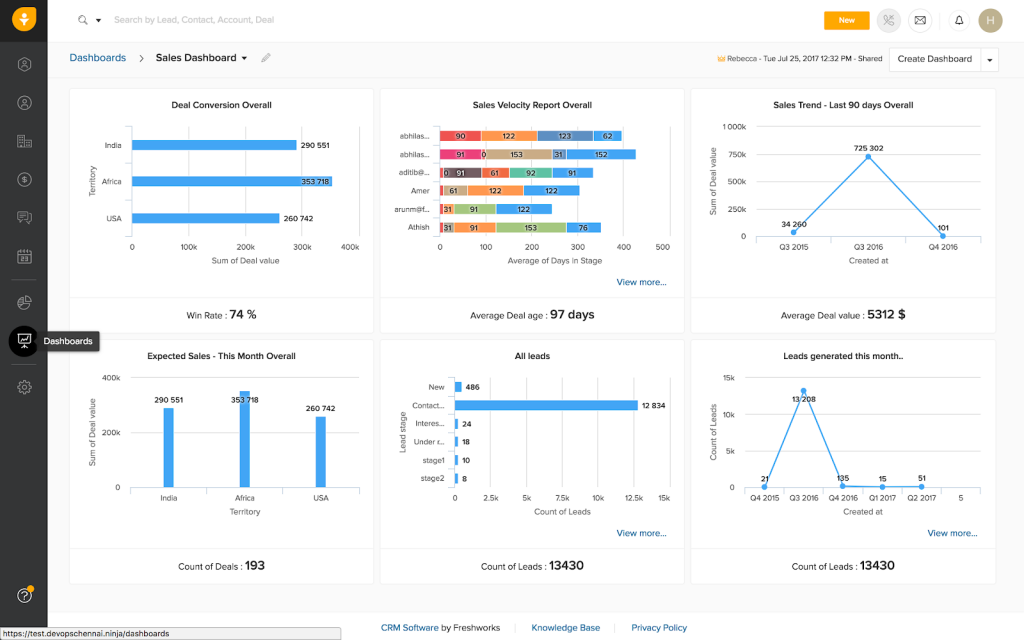
FreshSales is another free CRM tool that’s well-loved by users. It’s not as fully-featured as some of the other solutions on this list, but it won’t cost you a dime to use so there really isn’t much to complain about!
For sales tracking purposes, FreshSales provides its customers with a 360 degree view of their leads from a single screen, which is very convenient. From lead demographic information to conversion rates, users can quickly find what they need in FreshSales.
Beyond contact management, the software also features lead scoring, sales task management, and a handy iOS and Android app.
If you want access to a more detailed sales reporting dashboard, more storage, automation capabilities, and customization options, you’ll need to upgrade to FreshSales’ paid plan. But for simple sales tracking, FreshSales for free might do the trick.
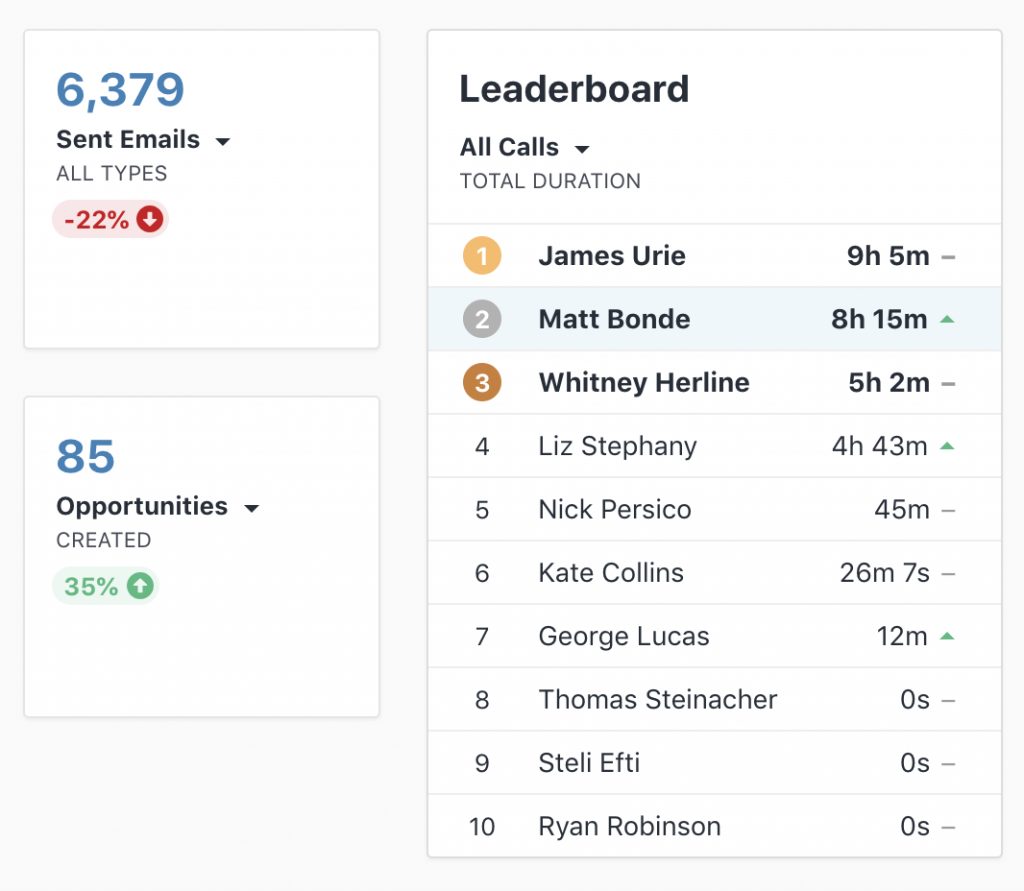
Close CRM is a sales tool that’s designed to help sellers close more deals. It does this via detailed reporting features that track individual sales rep and team performance, giving high-level pipeline overviews, analyzing call, email, and text success rates, and more.
Close CRM also features won and lost opportunities tracking, generated revenue metrics, and a sales rep leaderboard to inspire friendly competition.
Like some of the other sales tracking software mentioned above, Close does more than simply track sales pipelines. It also gives users access to email and SMS messaging tools and in-app phone and video calling so that all sales activities happen in the same interface.

Salesforce is a popular lead tracking tool that helps sales teams track leads throughout the entire sales cycle and improve performance through data analysis.
This tool includes features like visual pipelines, sales forecasting, contact management, and much more. Salesforce also offers plenty of customization options and scalability, which are especially beneficial for larger organizations.
However, the higher cost and complexity of Salesforce may create challenges for some businesses. Implementing and optimizing the system is often a lengthy process and may require assistance from outside consultants.
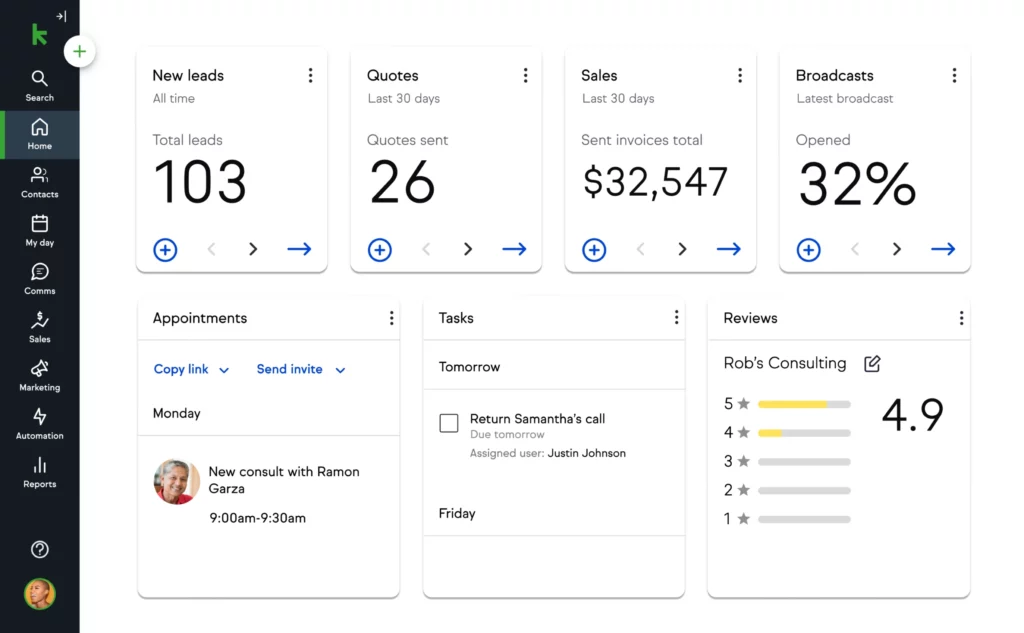
Lastly, we have Keap—a popular CRM with comprehensive sales tracking capabilities that help sales reps to manage leads and build customer relationships.
Keap includes sales tracking features such as visual sales funnels, in-depth sales reports, and sales forecasting. It also includes contact management features and numerous automation capabilities that help sales teams operate more efficiently.
Keap mainly focuses on small businesses, so it’s a great choice for small or mid-sized companies. Larger businesses or users that require more customization may find that Keap isn’t quite flexible enough for their needs.
With so many factors to consider, how do you choose the right sales tracking software tool? Here are some of the most important factors to consider:
Nutshell has what you need.
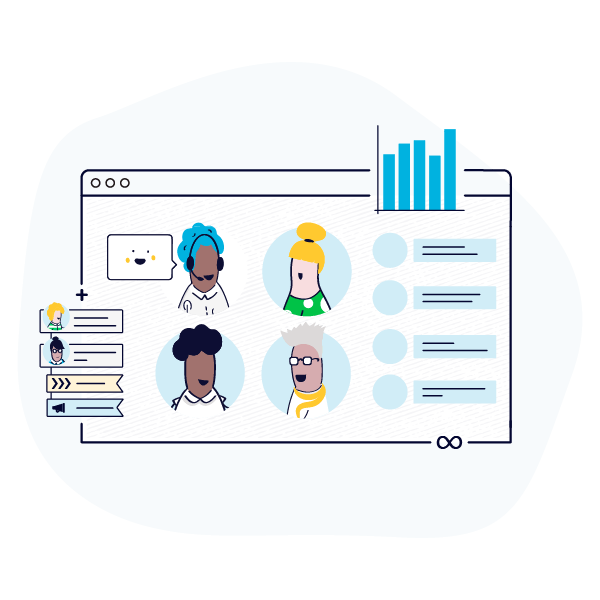
When choosing a sales tracking software, one of the most important considerations is, of course, the features included. Below are eight of the most important features that any good sales tracking tool should have. Make sure that the tool you invest in has the following eight features:
As a salesperson, acquiring new leads is always a top priority. Because of this, the sales tracking software you choose should allow you to easily source important information for each of the leads in your pipeline. Specifically, you’ll want to know:
When selecting sales tracking software, make sure it will allow you to keep detailed records on each of your leads so that you have the tools you need to close deals.
Related: Growth software: What it is and why your team needs it
Sales forecasting is the act of predicting future sales numbers. Many companies use sales forecasts to make important business decisions, predict upcoming performance, and properly allocate organizational resources.
But it’s not an exact science and companies get into hot water when they forecast incorrectly. You don’t want this to happen to your business!
To help guard against inaccurate sales forecasting, invest in a sales tracking tool that will allow you to see past and current sales data for your entire sales team, and predict future sales based on those numbers with relative precision.
Sales forecasting also involves knowing your customers, including how much of a broad customer base you can reach. Using a Total Addressable market or TAM Calculator can help you identify new revenue opportunities and generate new leads.
The best sales tracking software will tell you a lot about your leads. But it should also track what you’re doing to reach your leads on a daily, weekly, or monthly basis. In other words, your sales tracking tool of choice should also catalog your sales activities.
This software feature is beneficial for sales reps because it will allow you to easily see when you last contacted a lead, the communication channel (phone, email, text, etc.) you used, whether you get a response or not, the total number of times you’ve contacted them, and more. This information can then be used to fine-tune a sales approach that closes the deal.
Activity monitoring is also great for sales managers, as it will allow them to better evaluate their sales reps, be a more effective coach, and craft more effective sales strategies based on data.
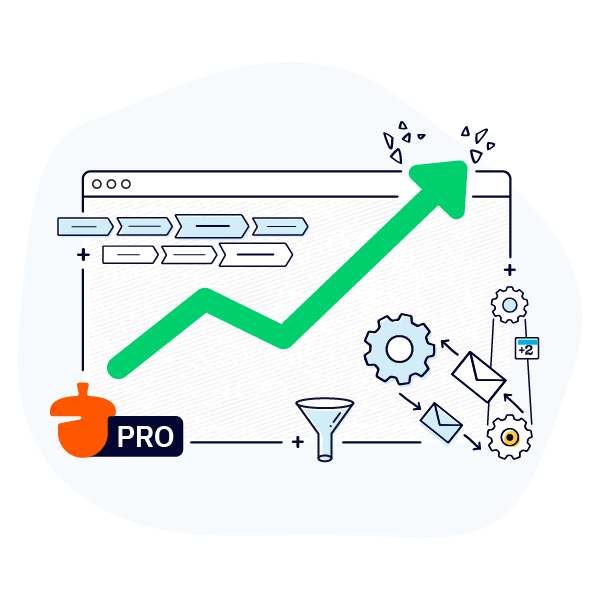
It’s important for you to keep a record of potential deals that fall through, i.e. your losses. While it may be painful to look at and study these numbers, knowing the specific reasons you’re losing deals (or the main competitors you’re losing deals to) helps you improve your selling approach and ensure that you don’t repeat the same mistakes in the future.
Analyzing your losses will also allow you to better forecast your sales numbers for a given month, quarter, or year. Speaking of forecasting…
Do you struggle to keep your sales pipeline flowing? Do your leads consistently get stuck in specific points of your funnel? If so, sales tracking software could be a life-saver.
Many sales tracker tools will allow you to view each section of your funnel in real time to see how close your leads are to a sale, what’s keeping prospects from traveling farther down your pipeline, and which sales tactics prove the most effective.
If you’re a visual learner, you might consider investing in a sales tracking software that will allow you to track opportunities in a visual pipeline. We’ll talk more about specific sales tracking solutions later in this guide.
Generating new leads takes time. If you’re able to convert more of the leads you already have into paying buyers, you can drive more revenue without working unrealistic hours.
One of the most productive ways to increase sales is to boost your conversion rate. A quality sales tracking software will automatically tally conversion rates for each individual sales rep on your team, or by lead source or other attributes. You can then study these metrics to learn how you can improve.
Additionally, sales managers can view which sellers have the highest conversion rates, analyze their tactics, and discover how top team members consistently close deals. This information can then be passed along to struggling reps.
Do you know how many deals you’ve closed this year? What about this quarter? When investing in sales tracking software, make sure the solution you choose will allow you to quickly view information regarding won opportunities and new sales.
As we mentioned above, knowing which deals you were able to close and the sales strategies you used to do so is valuable information, as it shows you the impact of your sales activities and the contributions of individual sales reps.
Just as professional football coaches watch tape of previous games to discover which plays worked best for them in the past, you should view your won opportunities so that you can pinpoint the most effective sales tactics available to you and deploy them more often.
The revenue per sale metric measures the average amount of revenue you make your company every time you close a deal. In general, the higher this number is, the better—as long as you can still close deals at a consistent clip.
Revenue per sale is especially useful if you sell different product tiers or offer multiple product upgrades. By assessing revenue per sale, you can discover how effective you (or your team, if you’re a sales manager) are at upselling your customers or pursuing the most valuable accounts.
A career in sales can often feel like a rollercoaster ride. But there are things you can do to make sure the highs are more frequent and the lows are less devastating. Namely, you can invest in sales tracking software.
Quality sales tracking software will help you better organize your leads, track sales rep activities, forecast future sales, and optimize important sales metrics like revenue per sale. But before you can enjoy these perks, you have to choose the right tool for your sales team.
While each of the 12 sales tracking solutions above have the ability to benefit your organization, we definitely feel like Nutshell is the best sale tracking software.
Try Nutshell for free for 14 days to learn if it’s the right sales tracking app for your company.
Nutshell is the customizable, all-in-one CRM and marketing software that helps B2B teams close more deals.
Try it for yourself with a 14-day trial — no credit card required!

Join 30,000+ other sales and marketing professionals. Subscribe to our Sell to Win newsletter!